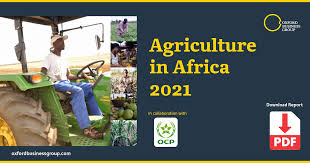Special Report on Agriculture in Africa 2021 (part 2)

Continued from (part 1)
By Bernardo Bruzzone, Africa Regional Editor, Oxford Business Group
Crops
While crop production is estimated to account for more than 75% of total agricultural production on the continent, there is a large degree of variation within Africa in terms of the regional, national and local production and consumption of crops. Wheat is the main staple in North Africa; Central and West Africa consume higher amounts of roots, tubers and plantains; and maize is central to the diet of those living in Southern Africa.
As a general trend, the number of agricultural crops produced, the share of land used for crop production and the total harvest value have seen large improvements over the course of the past decade. The FAO registered 2.86% annual growth in the net value of crop production during the 2010-19 period. The production of roots and tubers increased the most among all categories of crops, with annual growth of 3.67% between 2010 and 2019, resulting in an average annual yield of 86.8m tonnes in 2017-19, up from 56.7m tonnes per year in 2007-09.
The FAO projects that root and tuber production will grow by an annual growth rate of 2.28% between 2020 and 2029, which would see yearly production rise to 112m tonnes by the end of the period. At that rate, the sub-Saharan African region alone would account for an estimated 41% of worldwide root and tuber production. Cereals, the most widely grown crop on the continent, also saw significant growth in annual production over the period, rising from an average of 109.7m tonnes in 2007-09 to 141m tonnes in 2017-19. With projected 1.66% annual growth between 2020-29, the expected cereal yield in 2029 is 169.4m tonnes.
While land use for crop production has grown slightly over the past decade, from 196.2m ha in 2007-09 to 210.1m ha in 2017-19, the FAO estimates that the next decade will see an annual reduction of 0.13%. The anticipated yield growth is instead expected to develop as a result of improved access to higher-yielding seeds and other important inputs such as fertiliser, along with optimized management practices and infrastructure development, including irrigation schemes.
Despite these improvements, however, crop yields and productivity in Africa remain low compared to the global average. For instance, average yields for maize are about 2.5 times higher in Asia and South America, and six times higher in North America. Meanwhile, African rice yields are roughly half the levels seen in Asia, and North American rice yields are close to four times higher.
According to data from AGRA, growth in average African yields for these two staple crops remained relatively stagnant between 2010 and 2020, with the exception of the continent’s wheat yield, which rose to global levels in 2011 before moderating below the world average in the years that followed.
Livestock and Poultry
Africa produced an annual average of 129.7m tonnes of meat in 2017-19 – an increase on 107.8m tonnes in 2007-09 – to represent average annual growth of 1.1% between 2010 and 2019. Beef production rose at more than twice the rate of general meat production during this period, with 6.7m tonnes produced in 2018 for an annual average growth rate of 2.5% since 2009, when 5.4m tonnes were produced. However, the FAO notes that beef yields declined by 0.5% over the same period due to insufficient infrastructure, low-quality feed and inadequate storage capacity.
FAO projections for 2029 indicate that a 17% increase in cattle and 5% growth in productivity will yield an additional 1.1m tonnes of bovine meat in the region over the next decade. If those figures are achieved, sub-Saharan Africa would contain 18% of the global bovine herd by 2029. The growth in ovine meat will be significantly higher during the same period, with projections indicating that Africa could increase its share of global sheep and goat production from roughly 1% of the global total at present to as much as 14% within 10 years.
Poultry production has also seen significant growth in recent years. The FAO reports that total poultry production for the continent stood at 5.7m tonnes in 2018, up from 4.2m tonnes in 2009. The three largest poultry-producing countries on the continent – South Africa (1.8m tonnes), Egypt (1.1m tonnes) and Morocco (720,000 tonnes) – together account for 62% of Africa’s total output.
The FAO outlook for 2029 projects a 25% increase of total livestock production in the next decade, primarily driven by poultry and milk production.
As a consequence of rapid and sustained urbanisation and the continued growth of the African middle class, changing consumption patterns are expected to boost demand for all types of meat. The Bill and Melinda Gates Foundation projects that demand for livestock will trigger greater increases in consumption in Africa than in any other region in the world, with demand for meat estimated to rise by 2.8% annually between 2007 and 2030.
Despite the growth in domestically produced meat products, the continent still imports $4.6bn worth of meat and edible offal every year. Local producers continue to struggle to compete with international exporters due to high transport and administrative costs.
According to the Institut du Sahel, livestock produced in Burkina Faso for export to Accra transits through as many as 50 different checkpoints during the 1000-km journey to the end market. Similar obstacles are noted in the International Food Policy Research Institute’s “Africa Agriculture Trade Monitor 2020”, which estimates that livestock traders pass through five checkpoints for every 100 km of travel in Côte d’Ivoire. Between Mauritania and Senegal, meanwhile, livestock traders paid $24 in bribes per 100 km.
Agro-industry Agro-industrial development has been limited in most countries in Africa, with the bulk of agricultural exports made up of raw products and the continent importing large amounts of higher-value finished agricultural goods.
An analysis by the ACET shows that the vast majority (75%) of sub-Saharan agro-processing enterprises operate on an artisanal and semi-artisanal scale. At that end of the spectrum, characterized by low productivity and limited market access, such businesses struggle to compete with larger industrial and semi-industrial international producers.
In addition, many face a scarcity of high-quality affordable inputs, resulting in an inability to produce at capacity. As a result, the ratio of agro-processing manufacturing value-added to agricultural value-added in Africa is below 50%, with the exception of Mauritius and South Africa. However, commercialisation of the agriculture sector, combined with greater linkages between farms and other sectors, could help to facilitate the growth of export-oriented agro-processing. Indeed, there are numerous opportunities for value addition within the sector, including for crops with growing international demand. AGRA notes that Africa has captured some of the processing value for grapes (where the value of processed to unprocessed products stands at 71%), sugar (15%) and tomatoes (11%). Most other agricultural products remain under processed. The International Trade Centre, which tracks both the value of trade and the potential for further trade in processed and unprocessed goods, reports that less than 2% of tea, sesame seeds and processed goods in 2019. Its export potential database highlights processed cocoa products, shea nuts, cashew nuts, fertilisers and fruit products as having some of the highest untapped export potentials in Africa. An ACET report on agricultural transformation lists the same products as very-high value, underexploited crops and products, along with flowers, meats, yam, sorghum, oil palm and cassava.
Cognisant of opportunities in the sector, African governments and international organisations have collaborated to achieve greater agricultural industrialisation. A key initiative that seeks to link agriculture and industry and promote value chain and market systems development is the Agri-business and Agro-Industry Development Initiative (3ADI+), supported by the FAO, the International Fund for Agricultural Development, the UN Industrial Development Organisation, the African Development Bank (AfDB) and the UN Economic Commission for Africa (UNECA). At the national level, many countries are promoting special economic zones (SEZs), and offering incentives to agro-processing businesses in the form of tax and Customs benefits, and access to infrastructure, power and trading
platforms. Among them is the SKB Triangle SEZ in West Africa, launched in 2018 as the region’s first cross-border SEZ. Jointly operated by Mali, Burkina Faso and Côte d’Ivoire, the zone aims to attract private investment in agribusiness and agro-industry.
Agriculture Financing
As global food demands continue to rise, with the World Bank forecasting a 70% increase by 2050, the agriculture sector will require $80bn in global investments every year. African food demands are projected to grow more rapidly; the World Bank has estimated that the total size of the market will approach $1trn by 2030.
Difficulty accessing capital is one of the major challenges faced by agri-businesses across Africa. Commercial loans are expensive, and most businesses operating in the sector are small and medium-sized enterprises (SMEs) with little collateral.
Commercial bank loans to the sector also fall short; as of 2018 the proportion of loans going to the agriculture sector was equivalent to 3% of total loan disbursements in Sierra Leone; 4% in Ghana, Kenya and Nigeria; 6% in Uganda; 8% in Mozambique;
and 12% in Tanzania. Moreover, estimates show that about 10% of African households in rural areas are connected to formal financial institutions. Innovations such as microfinance and mobile banking provide opportunities to boost African farmers’ access to loans. As mobile penetration has increased in recent years, reaching 44% in
2017 in Africa, local entrepreneurs and international institutions have developed digital financial solutions aimed at supporting farmers.
Alternative forms of financing, including private equity (PE), have become a small but growing source of funding for agribusinesses.
Between 2010 and July 2020 business information platform Crunchbase reported 242 agriculture-related deals in Africa, raising $616m from entities such as NGOs, foundations, banks, angel investor networks and private investment funds. PE funded 19.4% of the total.
There are a number of private investment entities focused on agriculture in Africa, with varying deal sizes. In addition, large African PE firms have raised generalist funds, including some focused on agriculture.
The approximately two dozen funds involved in smaller deals with ticket sizes under $10m are often specialised and provide capital to SMEs. They also facilitate impact investment and investment in frontier markets, with capital coming predominantly from development finance institutions.
Venture capital is also becoming an increasingly important – albeit still relatively minor – part of the funding ecosystem, as angel investors move to fund agricultural start-ups across the continent.
As of 2018, there were 82 African agri-tech start-ups, around half of which were launched between 2016 and 2018. In 2017 agriculture ventures raised $59m in the capital. Agri-tech start-ups comprised $13.2m of the total, according to data from Crunchbase – an increase of 203% from 2016.
Source: Oxford Business Group
To be continued





